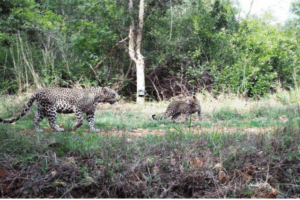Published on: June 6, 2025
LEOPARD POPULATION IN KARNATAKA
LEOPARD POPULATION IN KARNATAKA
CONTEXT
- Bengaluru’s outskirts, especially around Bannerghatta National Park (BNP), are witnessing increased leopard presence amidst growing urbanisation.
- The findings hold key implications for wildlife conservation policy, especially in peri-urban landscapes.
CONCEPT
- Urban Wildlife Interface: Leopards (Panthera pardus) are adapting to fragmented habitats, agricultural lands, and even private layouts due to habitat shrinkage.
- Biodiversity Hotspot:
- 80–85 leopards recorded in a 282 sq km area.
- Coexistence with 4 endangered species: Tiger, Dhole, Elephant, Indian Pangolin.
- 34 mammal species identified in total; 22 under Schedule I, 5 under Schedule II of Wildlife (Protection) Act, 1972.
- Monitoring Method:
- Over 250 camera traps used.
- Spatially Explicit Capture-Recapture (SECR) method helped estimate population and density.
- Unique rosette patterns on leopards used for identification.
CURRENT
- Leopard population trend in BNP:
- 2019: 40 → 2020: 47 → 2025: 54 (↑ due to protection, prey recovery, and past translocations).
- Urban Pressure:
- Bengaluru now encroaches BNP’s northern boundary, leaving no buffer zone.
- Habitat conflict rising due to decline in natural prey, leading to livestock predation.
- Conservation Recommendations:
- Notify BM Kaval, UM Kaval, Roerich Estate, Gollahali Gudda as conservation reserves.
- Expand BNP by adding Durga Dhakal RF, Bettahalliwade Block B, and deemed forests.
- Secure Muneshwara–Bannerghatta corridor and enhance community outreach.
- Ecological Importance:
- Bannerghatta acts as a link to Cauvery Wildlife Sanctuary (CWS) and forests in Tamil Nadu, enabling genetic diversity and dispersal.


You must be logged in to post a comment.